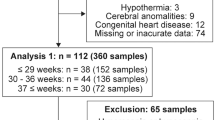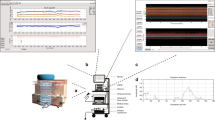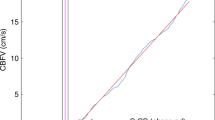Summary
The critical closing pressure (CrCP) of the cerebral vasculature is the arterial blood pressure (ABP) at which cerebral blood flow (CBF) ceases. Because the ABP of preterm infants is low and close to the CrCP, there is often no CBF during diastole. Thus, estimation of CrCP may become clinically relevant in preterm neonates. Transcranial Doppler (TCD) ultrasound has been used to estimate CrCP in preterm infants. Diffuse correlation spectroscopy (DCS) is a continuous, noninvasive optical technique that measures microvascular CBF. Our objective was to compare and validate CrCP measured by DCS versus TCD ultrasound. Hemorrhagic shock was induced in 13 neonatal piglets, and CBF was measured continuously by both modalities. CrCP was calculated using a model of cerebrovascular impedance, and CrCP determined by the two modalities showed good correlation by linear regression, median r 2 = 0.8 (interquartile range (IQR) 0.71–0.87), and Bland-Altman analysis showed a median bias of −3.5 (IQR −4.6 to −0.28). This is the first comparison of CrCP determined by DCS versus TCD ultrasound in a neonatal piglet model of hemorrhagic shock. The difference in CrCP between the two modalities may be due to differences in vasomotor tone within the microvasculature of the cerebral arterioles versus the macrovasculature of a major cerebral artery.
Access this chapter
Tax calculation will be finalised at checkout
Purchases are for personal use only
Similar content being viewed by others
References
du Plessis A, Volpe JJ (2002) Perinatal brain injury in the preterm and term newborn. Curr Opin Neurol 15(2):151–157
Perlman J (1998) White matter injury in the preterm infant: an important determination of abnormal neurodevelopment outcome. Early Hum Dev 53(2):99–120
O’Leary H, Gregas MC, Limperopoulos C et al (2009) Elevated cerebral pressure passivity is associated with prematurity-related intracranial hemorrhage. Pediatrics 124:302–309
Rhee CJ, Kaiser JR, Rios DR et al (2016) Elevated diastolic closing margin is associated with intraventricular hemorrhage in premature infants. J Pediatr 174:52–56
Romagnoli C, Giannantonio C, De Carolis MP, Gallini F, Zecca E, Papacci P (2006) Neonatal color Doppler US study: normal values of cerebral blood flow velocities in preterm infants in the first month of life. Ultrasound Med Biol 32:321–331
Rhee CJ, Fraser CD, Kibler K et al (2015) The ontogeny of cerebrovascular critical closing pressure. Pediatr Res 78(1):71–75
Varsos GV, Kolias AG, Smielewski P et al (2015) A noninvasive estimation of cerebral perfusion pressure using critical closing pressure. J Neurosurg 123:638–648
Wolfberg AJ, du Plessis AJ (2006) Near-infrared spectroscopy in the fetus and neonate. Clin Perinatol 33:707–728. viii
Buckley EM, Parthasarathy AB, Grant PE, Yodh AG, Franceschini MA (2014) Diffuse correlation spectroscopy for measurement of cerebral blood flow: future prospects. Neurophotonics 1(1):011009
Perlman J, Volpe JJ (1986) Intraventricular hemorrhage in extremely small premature infants. Am J Dis Child 140(11):1122–1124
Volpe JJ (1997) Brain injury in the premature infant. Neuropathology, clinical aspects, pathogenesis, and prevention. Clin Perinatol 24(3):567–587
Diop M, Verdecchia K, Lee T-Y et al (2012) Calibration of diffuse correlation spectroscopy with a time-resolved near-infrared technique to yield absolute cerebral blood flow measurements. Biomed Opt Express 3:1476
Giovannella M, Adnresen B, Andersen JB et al (2019) Validation of diffuse correlation spectroscopy against 15O-water PET for regional cerebral blood flow measurement in neonatal piglets. JCBFM 2019:271678X19883751. https://doi.org/10.1177/0271678X19883751
Buckley EM, Cook NM, Durduran T et al (2009) Cerebral hemodynamics in preterm infants during positional intervention measured with diffuse correlation spectroscopy and transcranial Doppler ultrasound. Opt Express 17:12571–12581
Busch DR, Rusin CG, Miller-Hance W et al (2016) Continuous cerebral hemodynamic measurement during deep hypothermic circulatory arrest. Biomed Opt Express 7:3461–3470
Baker WB, Parthasarathy AB, Gannon KP et al (2017) Noninvasive optical monitoring of critical closing pressure and arteriole compliance in human subjects. J Cereb Blood Flow Metab 37:2691–2705
Andresen B, De Carli A, Fumagalli M et al (2019) Cerebral oxygenation and blood flow in normal term infants at rest measured by a hybrid near-infrared device (BabyLux). Pediatr Res 86(4):515–521. https://doi.org/10.1038/s41390-019-0474-9
Acknowledgments
C.J.R. is supported by the National Institutes of Health (1K23NS091382). D.R.R. is supported by the National Institutes of Health (1K23HLI130522). The technical assistance of Leticia McGuffey was greatly appreciated.
Author information
Authors and Affiliations
Corresponding author
Editor information
Editors and Affiliations
Ethics declarations
Dr. Rusin has an significant financial interest in Medical Informatics Corp. MIC has no financial interests in this work.
Rights and permissions
Copyright information
© 2021 Springer Nature Switzerland AG
About this chapter
Cite this chapter
Elizondo, L.I. et al. (2021). Critical Closing Pressure by Diffuse Correlation Spectroscopy in a Neonatal Piglet Model. In: Depreitere, B., Meyfroidt, G., Güiza, F. (eds) Intracranial Pressure and Neuromonitoring XVII. Acta Neurochirurgica Supplement, vol 131. Springer, Cham. https://doi.org/10.1007/978-3-030-59436-7_55
Download citation
DOI: https://doi.org/10.1007/978-3-030-59436-7_55
Published:
Publisher Name: Springer, Cham
Print ISBN: 978-3-030-59435-0
Online ISBN: 978-3-030-59436-7
eBook Packages: MedicineMedicine (R0)




